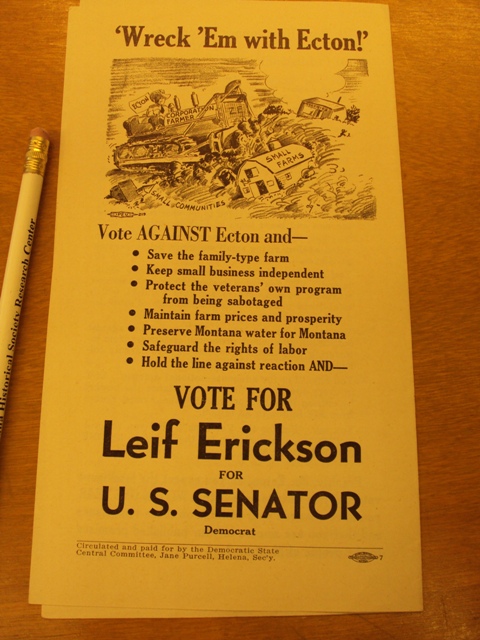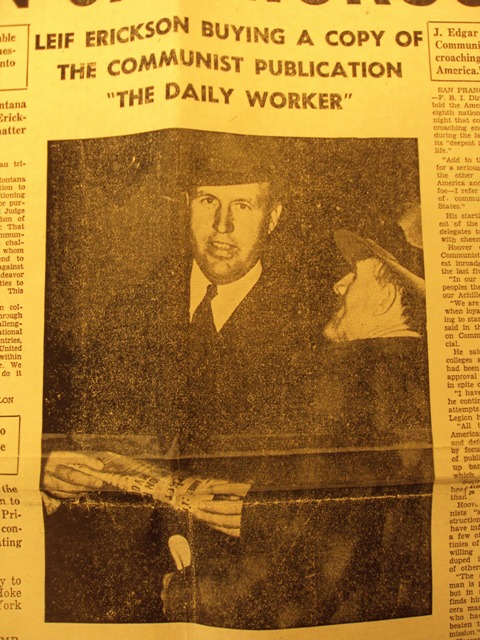This can happen when you did through the biographical folders of Montana’s past politicians. Today I’d like to look at some of these flyers, handouts, and campaign literature so that you can figure out what worked then…and what might work for you.
Governor Roy Ayers
On the inside you get a county seat number list. We had one of these in our car growing up, from some long-forgotten politician, but we kept it for years because of that county number chart, which anyone driving down Montana’s highways can appreciate. Today’s candidates would do well to follow this time-tested precedent.
Roy Ayers squeaked through his 1940 primary by 1% and then lost his reelection bid that November to Sam “Model T” Ford, 51% to 49%. Fewer than 5,000 votes separated the men, so Communist candidate Arvo Fredrickson couldn’t really be blamed, although in the bars around the state that night he no doubt was. What should have been blamed was the rising resurgence of the Republican Party and the growing split developing in the Democratic Party.
“Republicans barely figured in political contests at all,” Malone tells us of the New Deal era in Montana. “But as always happens,” he goes on to say of the one-party dominance that that state experienced during the 1930s, “the lopsided Democratic majority soon factionalized and broke up.”
Ayers felt that firsthand. In 1944 he came back and tried again for governor, but was defeated in the primary by Leif Erickson, another Montanan that’d left the Supreme Court to get into the mire of politics. Erickson was good at it, and bested the former governor 47% to 23%. It wouldn’t sound too bad except there was another candidate that pulled in 29%. Montana, it seemed, was ready to move on from the lawyer and rancher from Lewistown. That’s where Ayers returned, and he enjoyed his remaining years on his ranch. He died on May 23, 1955. He was 72 years old.
The Fiery Leif Erickson
In 1946, upset over his gubernatorial loss as well as the ineptitude of Senator Burton Wheeler, Erickson ran in the U.S. Senate primary. He beat out the decades-long Wheeler and was going head to head with Zales Ecton in the general. Here’s one of his flyers:
Voters decided that Ecton would be better, and he won 54% to 45%.
Republicans had gained control of two of the state’s four national offices. They also had the governorship and the legislature. Nationally that year, the Democrats lost fifty-five seats in the House and twelve seats in the Senate. Congress was lost to them, the worst defeat the party had suffered since 1928 when Hoover had come to power. In Montana, Erickson took much of the blame. Another casualty was the Missouri Valley Authority. Erickson had been a big supporter of the MVA, but 1946 wasn’t the year for Democrats and when he went down to Ecton the MVA’s chances diminished further. Massive flooding of the Missouri in 1947 revived the bill a little, but again nothing happened.
Erickson lost for a variety of reasons in 1946, but the dirty Republican tricks and a bad economy were chief amongst them. The press didn’t help, either, although some of Erickson’s actions exacerbated that. For instance, he’d bought The Daily Worker, “considered a Communist paper,” and from a Helena man “known to be mentally unstable.” The large newspapers of the state had gotten a picture of the deal, and they paraded it about, using it to question Erickson’s patriotism.
Erickson served as a Democratic National Committeeman from 1962 to 1973 and then his time in Montana politics was effectively done. Leif Erickson settled in Missoula, where he died on December 22, 1998. He was 92 years old.











